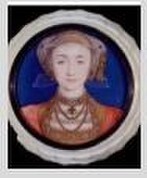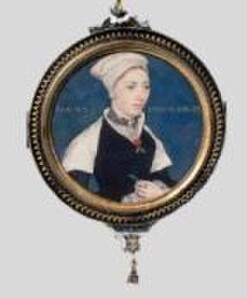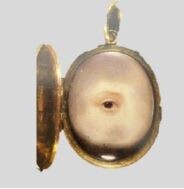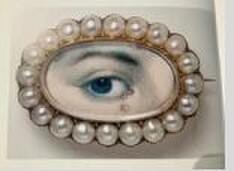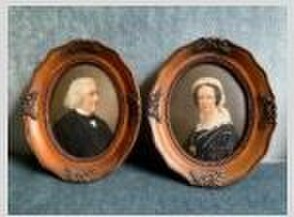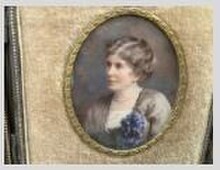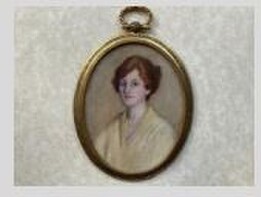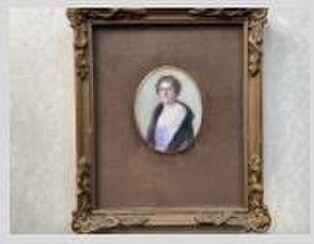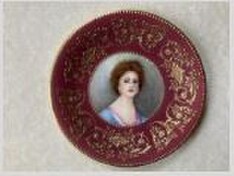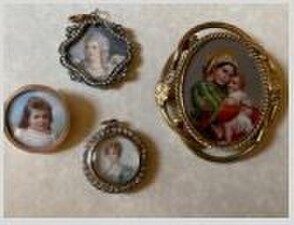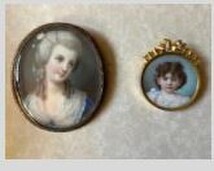Jo Armstrong’s talk to the Circle, April 2023
The art of Limning, that is painting miniatures, came from the workshops of illuminators of the Ghent-Bruges School, and, as with all technical “mysteries”, was kept a carefully guarded secret. Despite this early secrecy, by the 18th century, miniature painting was widespread. The term “miniature” comes from the word “miniature”, which was the Italian for Limning.
There was also a tradition in India of miniature painting which can be traced from the 9th century in the Buddhist Pala period, and it reached its pinnacle during the Mughal era. They were originally painted on leaves until white paper was introduced in the 12th century.
Portrait miniatures were first painted in England in the 1520s during the reign of Henry VIII and in the French Court of Francis 1st.
Henry’s portraitist Hans Holbein painted some of the earliest and most beautiful miniatures. He travelled to the Continent to paint Ann of Cleves to allow Henry to judge the beauty of the woman he planned to marry. Famously, Henry was less pleased with reality than the flattering portrait and divorced Ann after 6 months.
A second Holbein miniature shows a plainly dressed woman, said to be Jane, wife of Nicholas Small, a London merchant and neighbour of Holbein. Another later well represented miniature artist was John Smart and the earliest reference to him was in January 1755 when he was awarded 2nd place in a new drawing competition for children under 14. The winner was Richard Cosway with whom Smart would form a lifelong rivalry.
Cosway was another prolific miniature artist of the time who married Maria Hatfield in 1781. It was thought to be a marriage of convenience as he was 20 years her senior. Maria was also a talented artist who was elected to the Art Academy of Florence in 1778. She also exhibited in London’s Royal
Academy of Arts.
Cosway actively discouraged her from working as it wasn’t considered proper for a woman to have a career and he forbade her from selling her paintings. It has been suggested that he felt threatened by her talent and was afraid she might eclipse his popularity. The Cosways had one child but they eventually separated. Unfortunately their daughter died when she was six.
In 1786 the Cosways were in Paris where they met Thomas Jefferson who would later become President of the United States. Jefferson fell in love with Maria and their attachment is documented in the letters she sent him, which he kept, along with copies of his letters to her. These were hidden by the Jefferson descendants until 1945. They corresponded until he died.
The earliest miniature portraits were painted on small discs of very fine Vellum, that is, animal skin. This was attached with corn starch paste to small pieces of pasteboard usually cut from playing cards on the plain side of the card. It was then pressed in a book until nearly dry, removed and placed face-down on a fine grinding stone and burnished until very smooth.
Early miniaturists may have used egg white as a binding medium for the few pigments available, but there is no doubt that gum Arabic was more commonly used. Gum Arabic is a natural gum from the sap of the Acacia tree.
The first Acacia species were discovered and documented in Africa in the 1700s, but years later, many hundreds of the species were found in Australia.
By the 17th century the size of miniatures had increased to about 3 inches or 8cm, using a base of card with a thin coating of gesso, which is a mixture of size and chalk which stiffened the card and prevented it from warping.
In the 18th and 19th centuries, ivory became the common base. As ivory was difficult to cut without damage, it was quite thick in the beginning, but later in the century they were able to cut more thinly, and these later bases were quite transparent.
Portraits on ivory often use tiny dots of watercolour because the surface was naturally oily and non-absorbent. The early 18th century was considered the “Golden Age” of miniature painting when ivory replaced vellum because despite the difficulties in applying the paint, the luminosity of ivory gave better skin tones.
Now, portrait miniatures are painted on a synthetic material known as “Ivorine”. There is also now available very fine matt porcelain known as “Porcelain Canvass”.
Miniatures were also painted in enamel on base metal and fired in the same way as porcelain, and as with porcelain, there was the advantage of being impervious to light so they did not fade; they are only damaged if they are dropped causing them to chip or break. The earliest known portrait miniature in enamel is a self-portrait of Jean Fouquet (1420 – 1480) which is now in the Louvre in Paris.
Miniatures on porcelain were not as common and often the artists were connected to the porcelain factories, particularly KPM. Some of these miniatures are from life, but it was also popular to have a miniature of an old master such as this study of the children of Charles 1st from a painting by Anthony Van Dyck.
By the 16th century it was no longer necessary for an artist or his apprentice to prepare crude pigments to produce their paints in the studio, their paints could be purchased in lump form from the Apothecary’s shop.
Modern tests show there were two types of white, one of which was lead. Lead, which was used extensively in the 17th century, had a serious problem, for, in the presence of hydrogen sulphide in the atmosphere, it would turn black. Fortunately, thanks to modern research, it is now possible for conservators to remove this damage.
Two carbon black pigments were used, one being lamp soot, called lamp black, and the other made by burning bones or horns of animals in an airtight crucible. This is known as ivory black as it was often made from burning off-cuts and shavings from ivory.
Reds were limited to vermillion and red lead. Yellows were varieties of ochre and sometimes tin lead yellow, or yellow sulphide of arsenic.
Rich blue for backgrounds was copper carbonate or a natural one described as blue bice which was made from the mineral azurite.
The rare blue-ultramarine was made from Lapis Lazuli, but it was not available until after 1600 and it was very expensive.
Powdered gold and silver were also used as pigments, usually to highlight armour, jewellery, gilt buttons or the embroidery on the sitter’s clothing.
Miniaturists had to be careful of the pigments they chose as they were not all durable. Reds were particularly vulnerable when exposed to light so that flesh colours often deteriorated. Early miniaturists also had to guard against disastrous chemical reactions from some colours, particularly Verdigris and copper blues and greens.
Brushes were not of one fine hair, as it is frequently stated as this would not have allowed a sufficient amount of colour to be applied.
Brushes were made from hairs taken from the tip of a squirrel’s tail and bound in small bundles with the hairs curving in to form a tip with which to paint. These hairs were then set into goose quills, the same as they are today. The longest lasting but most expensive brushes today use sable hair.
During the 18th century and a little later, miniatures of a single eye became fashionable. These were usually very small as they were intimate mementoes set in lockets, rings and brooches. They became popular because the Prince of Wales had Mrs Fitzherbert’s eye painted by George Engleheart. One of the earliest examples was painted by Richard Cosway in 1786.
There are also so-called weeping eye portraits depicting the eyes of deceased loved ones where tears were depicted by attaching crystals, diamonds or pearls.
At the time there was a cult of sentimentality which included other mourning jewels containing hair. These rare miniatures are hard to find and very expensive, so I have knocked up my own.
Surprisingly, the first miniature to be acquired by the Victoria & Albert museum is of Elizabeth 1st by Hilliard, and it was purchased in 1857 by the Enamels Department for its enamelled locket case, rather than for the miniature itself.
Originally, the V&A had no plans to collect miniatures, but in 1862 they staged an exhibition of borrowed miniatures. This exhibition excited such public interest that Newsletter May 2023 Page 9 there was a further exhibition in 1865 of 3,000 miniatures some of which have since been acquired by the V&A.
Photography effectively replaced the need for miniaturists and although early photographs were only black and white, they could be hand tinted with colour. I have one example on glass, and tinted.
This is a very brief history, but I will now discuss the items in my collection which of course started with portraits on porcelain. These two oval portrait plaques were unframed and signed P.B. Beetz, Dresden, 1877. I purchased them at an Antiques fair in England in 1989. Unfortunately, not many of these plaques are signed or have any factory marks.
This study of around the same date has fine details in raised gold.
One which does display information is this portrait of a lady which has pencilled on the back “Hoffoinber ‘6 de’ Holland”.
These two small ones provide no information but one may be from the 1930s judging by the outfit she is wearing.
I have two more recent examples painted by Bernice Edwell. Bernice was born in Newbury, Berkshire, and came to Sydney where she studied at the Royal Academy, Sydney. She also studied at Colagrossi’s in Paris. Bernice was a well-known miniaturist who exhibited in Sydney and at the Royal Academy in London in 1921 and 1923. Her work is represented in both the Melbourne and Sydney State Galleries.
Because I have no boundaries in regard to my collecting, I also have two very modern portrait miniatures. This 5cm round portrait is by Jane Marks, a renowned American portrait artist, and it was painted in 1990.
Also this portrait painted by a local artist Betty Jeffrey; it was the winner of the Miniature Section at the Sherbrooke Art Gallery exhibition.
The smallest portrait I have attempted is this small plate with a border of raised gilding.
I would also like to mention Russian lacquer miniatures, most of which come from Fedoskino, an old village 30 km from Moscow on the banks of the Ucha River. This village, since the 18th century, has been known for lacquer miniatures painted on papier mâché which is sometimes inset with slivers of mother-of-pearl to add highlights to the painting.
